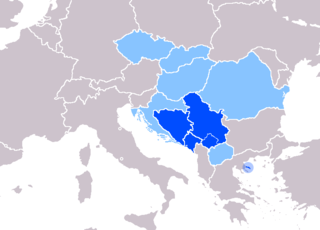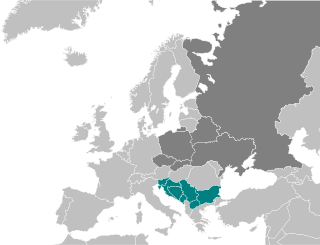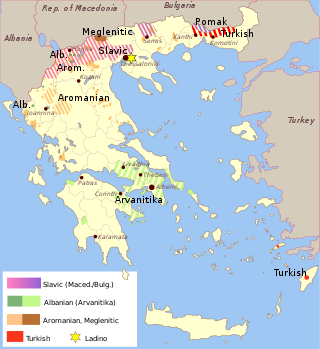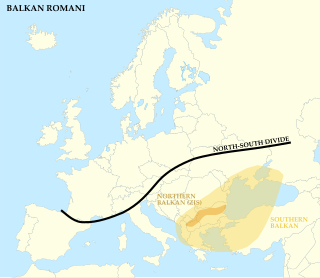See also
Countries on the Balkan Peninsula | ||
|---|---|---|
| Geographically fully located | ||
| Significantly located | ||
| Partially located | ||
| Mostly outside the peninsula |
| |
| See also | ||
| Authority control databases: National |
|---|
This is a list of languages spoken in regions ruled by Balkan countries. With the exception of several Turkic languages, all of them belong to the Indo-European family. A subset of these languages is notable for forming a well-studied sprachbund , a group of languages that have developed some striking structural similarities over time.
These are the extinct languages that were once spoken in the Balkans:

The Balkans, corresponding partially with the Balkan Peninsula, is a geographical area in southeastern Europe with various geographical and historical definitions. The region takes its name from the Balkan Mountains that stretch throughout the whole of Bulgaria. The Balkan Peninsula is bordered by the Adriatic Sea in the northwest, the Ionian Sea in the southwest, the Aegean Sea in the south, the Turkish straits in the east, and the Black Sea in the northeast. The northern border of the peninsula is variously defined. The highest point of the Balkans is Musala, 2,925 metres (9,596 ft), in the Rila mountain range, Bulgaria.

Serbo-Croatian – also called Serbo-Croat, Serbo-Croat-Bosnian (SCB), Bosnian-Croatian-Serbian (BCS), and Bosnian-Croatian-Montenegrin-Serbian (BCMS) – is a South Slavic language and the primary language of Serbia, Croatia, Bosnia and Herzegovina, and Montenegro. It is a pluricentric language with four mutually intelligible standard varieties, namely Serbian, Croatian, Bosnian, and Montenegrin.

Serbian is the standardized variety of the Serbo-Croatian language mainly used by Serbs. It is the official and national language of Serbia, one of the three official languages of Bosnia and Herzegovina and co-official in Montenegro and Kosovo. It is a recognized minority language in Croatia, North Macedonia, Romania, Hungary, Slovakia, and the Czech Republic.
A dialect continuum or dialect chain is a series of language varieties spoken across some geographical area such that neighboring varieties are mutually intelligible, but the differences accumulate over distance so that widely separated varieties may not be. This is a typical occurrence with widely spread languages and language families around the world, when these languages did not spread recently. Some prominent examples include the Indo-Aryan languages across large parts of India, varieties of Arabic across north Africa and southwest Asia, the Turkic languages, the Chinese languages or dialects, and parts of the Romance, Germanic and Slavic families in Europe. Terms used in older literature include dialect area and L-complex.

Southern Europe is the southern region of Europe. It is also known as Mediterranean Europe, as its geography is marked by the Mediterranean Sea. Definitions of southern Europe include some or all of these countries and regions: Albania, Andorra, Bosnia and Herzegovina, Bulgaria, Croatia, Cyprus, Gibraltar, Greece, Italy, Kosovo, Malta, Monaco, Montenegro, North Macedonia, Portugal, San Marino, Serbia, Slovenia, southern France, Spain, Turkey, and Vatican City.

The South Slavic languages are one of three branches of the Slavic languages. There are approximately 30 million speakers, mainly in the Balkans. These are separated geographically from speakers of the other two Slavic branches by a belt of German, Hungarian and Romanian speakers.

Southeast Europe or Southeastern Europe (SEE) is a geographical subregion of Europe, consisting primarily of the cultural region of Balkans, as well as adjacent regions and archipelagos. There are overlapping and conflicting definitions of the region, due to political, economic, historical, cultural, and geographical considerations.
The Balkan sprachbund or Balkan language area is an ensemble of areal features—similarities in grammar, syntax, vocabulary and phonology—among the languages of the Balkans. Several features are found across these languages though not all apply to every single language. The Balkan sprachbund is a prominent example of the sprachbund concept.

Shtokavian or Štokavian is the prestige supradialect of the pluricentric Serbo-Croatian language and the basis of its Serbian, Croatian, Bosnian and Montenegrin standards. It is a part of the South Slavic dialect continuum. Its name comes from the form for the interrogative pronoun for "what" što. This is in contrast to Kajkavian and Chakavian.

South Slavs are Slavic people who speak South Slavic languages and inhabit a contiguous region of Southeast Europe comprising the eastern Alps and the Balkan Peninsula. Geographically separated from the West Slavs and East Slavs by Austria, Hungary, Romania, and the Black Sea, the South Slavs today include Bosniaks, Bulgarians, Croats, Macedonians, Montenegrins, Serbs and Slovenes.

Torlakian, or Torlak, is a group of transitional South Slavic dialects of southeastern Serbia, Kosovo, northeastern North Macedonia, and northwestern Bulgaria. Torlakian, together with Bulgarian and Macedonian, falls into the Balkan Slavic linguistic area, which is part of the broader Balkan sprachbund. According to UNESCO's list of endangered languages, Torlakian is vulnerable.

The Slavic dialects of Greece are the Eastern South Slavic dialects of Macedonian and Bulgarian spoken by minority groups in the regions of Macedonia and Thrace in northern Greece. Usually, dialects in Thrace are classified as Bulgarian, while the dialects in Macedonia are classified as Macedonian, with the exception of some eastern dialects which can also be classified as Bulgarian. Before World War II, most linguists considered all of these dialects to be Bulgarian dialects. However, other linguists opposed this view and considered Macedonian dialects as comprising an independent language distinct from both Bulgarian and Serbo-Croatian.
Languages of Yugoslavia are all languages spoken in former Yugoslavia. They are mainly Indo-European languages and dialects, namely dominant South Slavic varieties as well as Albanian, Aromanian, Czech, German, Italian, Venetian, Balkan Romani, Romanian, Pannonian Rusyn, Slovak and Ukrainian languages. There are also pockets where varieties of non-Indo-European languages, such as those of Hungarian and Turkish, are spoken.

The official language of Greece is Greek, spoken by 99% of the population. In addition, a number of non-official, minority languages and some Greek dialects are spoken as well. The most common foreign languages learned by Greeks are English, German, French and Italian.

The official language of North Macedonia is Macedonian, while Albanian has co-official status. Macedonian is spoken by roughly two-thirds of the population natively, and as a second language by much of the rest of the population. Albanian is the largest minority language. There are a further five national minority languages: Turkish, Romani, Serbian, Bosnian, and Aromanian. The Macedonian Sign Language is the country's official sign language.

The geographical distribution of speakers of Macedonian refers to the total number of native speakers of Macedonian, an East South Slavic language that serves as the official language of North Macedonia. Estimates of the number of native and second language speakers of Macedonian varies; the number of native speakers in the country ranges from 1,344,815 according to the 2002 census in North Macedonia to 1,476,500 per linguistic database Ethnologue in 2016. Estimates of the total number of speakers in the world include 3.5 million people. Macedonian is studied and spoken as a second language by all ethnic minorities in the country.

Balkan Roma, Balkaniko Romanes, or Balkan Gypsy is a specific non-Vlax dialect of the Romani language, spoken by groups within the Balkans, which include countries such as Albania, Bosnia-Herzegovina, Bulgaria, Greece, Kosovo, North Macedonia, Serbia, Slovenia, Turkey etc. The Balkan Romani language is typically an oral language.

The dialects of Serbo-Croatian include the vernacular forms and standardized sub-dialect forms of Serbo-Croatian as a whole or as part of its standard varieties: Bosnian, Croatian, Montenegrin, and Serbian. They are part of the dialect continuum of South Slavic languages that joins through the transitional Torlakian dialects the Macedonian dialects to the south, Bulgarian dialects to the southeast and Slovene dialects to the northwest.

The Albanian–Romanian linguistic relationship is a field of the research of the ethnogenesis of both peoples. The common phonological, morphological and syntactical features of the two languages have been studied for more than a century. Both languages are part of the Balkan sprachbund but there are certain elements shared only by Albanian and Romanian and its close relatives descended from Common Romanian. Aside from Latin, and from shared Greek, Slavic and Turkish elements, other characteristics and words are attributed to the Paleo-Balkan linguistic base: Illyrian, Thracian, Dacian and/or Thraco-Illyrian, Daco-Thracian. Similarities between Romanian and Albanian are not limited to their common Balkan features and the assumed substrate words: the two languages share calques and proverbs, and display analogous phonetic changes.
The various regional and minority languages in Europe encompass four categories: